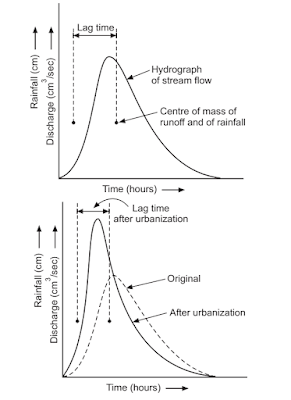GEOLOGICAL HAZARDS OF RUNNING WATER - ENGINEERING GEOLOGY (StudyCivilEngg.com)
GEOLOGICAL HAZARDS OF RUNNING WATER
SUBJECT : ENGINEERING GEOLOGY
In other words, the main effect of urbanization is to increase run-off, which, in turn, causes increased erosion followed by deposition of eroded material in downstream areas. The resulting flooding, erosion and deposition may also occur in urbanised area.
In a given drainage basin, a rainfall will cause an increase in the inflow of the main stream. The length of the time lag and the amount of increase in the flow will depend upon the amount and intensity of the rainfall as well as on the characteristics of the river. Below figure shows an example.
Urbanization of a drainage basin will increase both the peak run-off and the total run-off because man made structures reduce the infiltration.
- The increase in discharge causes increased erosion. The initial effect is a deepening of the channel and removal of accumulated sediment load leading to increase the river capacity so that it can carry more water without flooding. As the main stream deepens, the tributaries also deepens because of lowering of their base level. Gullies may appear at many places in the drainage basin. The increased run-off means less infiltration and proportionally lesser recharge of groundwater supply.
- A dam causes changes in a stream. Dams have finite lives because of sedimentation in the reservoirs. This upstream deposition causes problems especially for farmers whose agriculture ditches are silted up. On the other hand erosion occurs on downstream side. As a result, stream deepens its channels. The tributaries also deepen proportional to the main stream.
- The increased erosion caused either by urbanization or dams may make the water muddy. The maximum amount of erosion occurs during the construction phase of urbanization when the natural slope of ground is altered.
Significance of River Deposition and Erosion in Civil Engineering
- Coarse sand or gravel deposited by river activity and that deposits have different uses in civil field like coarse sand and gravel are used as construction material as a concrete aggregate.
- Fine river deposits used as fine aggregates, its very porous and permeable.
- Clay size alluvial deposits used for earthen dam.
- Silt and clay type alluvial soil has good plasticity and mostly utilize for rock fill dam.
- Alluvial soil mostly content tin ore deposits and some region gold, platinum, gemstone.
- Alluvial soil mostly used in industry to make pottery and bricks.
- It has low shear strength, so construction on alluvial soil require pile foundation or raft foundation, but it's based on soil condition or structure.
- Alluvial soil has low bearing capacity so heavy structure on soil may not be stable.
- If bridge constructed on alluvial soil, then pier must reach up to hard strata otherwise structure will not be stable for longer time.
FAQs COVERED IN THIS POST
What are the Geological Hazards of Running water?
What is significance of river deposition and erosion in Civil Engineering?
What are the main effects of Urbanization?
How can a dam impact the stream?
What are causes of Erosion?
What is the best soil for Bridge construction?
RELATED POSTS
- SURVEYING - STUDY ONLINE
- BUILDING MATERIALS AND CONSTRUCTION - STUDY ONLINE
- FLUID MECHANICS - STUDY ONLINE
- SOIL MECHANICS - STUDY ONLINE






Post a Comment